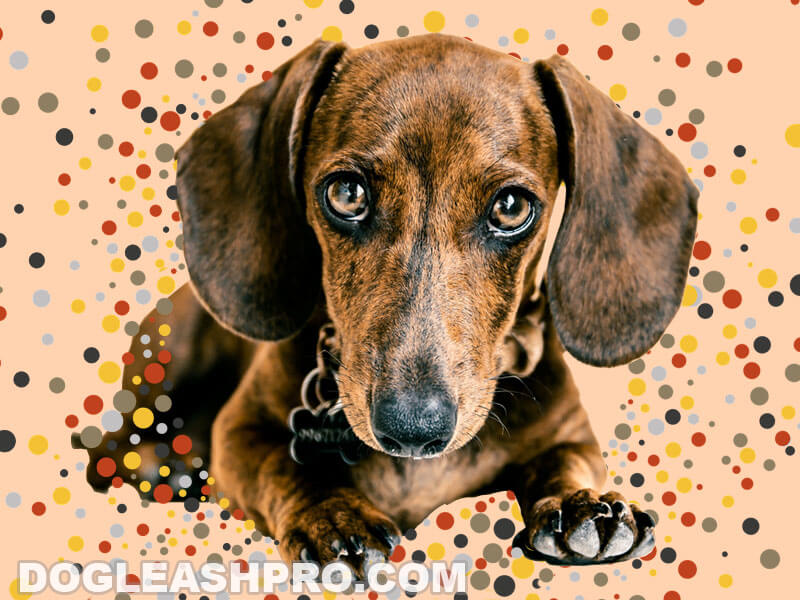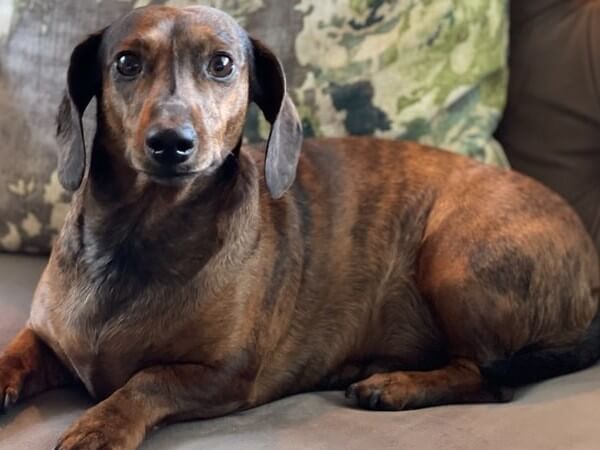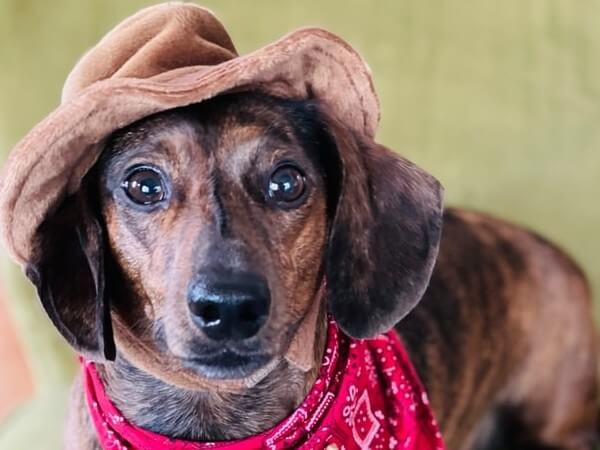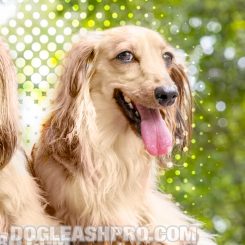
Do you love Dachshunds and are thinking about getting one? Do you prefer a Dachshund with a distinguished and unique coat pattern or a Dachshund with traditional coat colors?
Perhaps you’ve seen a Brindle Dachshund on your way home and their beautiful coat pattern piqued your interest. If you’re looking to learn more about the Brindle Dachshund, you’ve landed on the right page.
In this comprehensive guide, we’ll discuss everything you need to know about the Brindle wiener dog including the genetics behind their Brindle pattern, their physical appearance, health issues, temperament, grooming and exercise requirement, dietary needs, and living conditions.
If you’re still interested in the Brindle weenie dog after reading this, we’ve listed a few breeders near the end of this guide with whom you can contact. Let’s first start with a breed overview of the Brindle Dachshund.
Table of Contents
Brindle Dachshund: Breed overview

| Brindle Dachshund | |
| Breed Type | Dachshund |
| Other Names | Doxie, Brindle Daschund, Brindle Dachsund |
| Purity | Purebred |
| Purpose | Great companions |
| AKC Recognition | No |
| Size | Small |
| Weight | 16 to 32 pounds |
| Height | 17 to 19 inches tall |
| Lifespan | 12 to 15 years |
| Colors | Black, chocolate, wild boar, grey or fawn with tan, Brindle |
| Child Friendliness | Yes |
| Canine Friendliness | Low |
| Training Difficulty | Low to Moderate |
| Grooming Upkeep | Minimal for short-hair; moderate for long or wired hair |
| Hypoallergenic | No |
| Breed Health | Bone, joint, and spinal injuries |
| Exercise Needs | 20-40 minutes/day |
| Puppy Costs | $1,000 to $2,500 |
What is a Brindle Dachshund?

Many mistakenly think that Brindle is a coat color, but Brindle is actually a coat pattern. A Brindle Dachshund has a coat with reddish-brown, fawn, or black stripes over a red, cream, or tan base color.
In order to have a Brindle Dachshund puppy, one of its parents must have the gene that carries the Brindle coat pattern.
The Brindle pattern can occur in any of three Dachshund varieties: longhair, wirehaired, or smooth coated.
When it comes to the Dachshund’s history, they were first bred in Germany, where they were known as Teckels or Dachshunds. Since Dachshunds are loyal and affectionate, they have become very popular as household pets.
Are Brindle Dachshunds rare?
No, Brindle Dachshunds are not rare but they are not as common as their non-Brindle counterparts.
While they’re not as uncommon as some other coat patterns in the Dachshund breed – like piebalds and dapples, for example – Brindles are still relatively rare compared to dogs with normal coats.
This is because breeding for a Brindle coat Dachshund is often intentional, as opposed to other coat patterns which are typically the result of random breeding.
Brindle Dachshund genetics
There are a few things to keep in mind when it comes to the genetics of Brindle coat pattern in Dachshunds.
First, the Brindle coat pattern is determined by the genes that the dog inherits from his parents.
Second, the Brindle pattern is caused by the agouti locus (A) gene, which controls how much black pigment (eumelanin) is produced on each hair strand. With this gene, there are two possible alleles: dominant black (A/A) which produces solid black dogs, and recessive red (a/a) which produces Brindles.
Finally, the distribution of pigment in the coat is what gives Brindle Dachshunds their unique appearance.
As we can see, when it comes to the genetics of Brindle Dachshunds, it is a little more complicated as compared to the genetics of other coat colors and patterns in Dachshunds.
While Brindle coat patterns look fascinating, it really boils down to how pigment production works in dogs.
A Brindle gene shows incomplete dominance, meaning that it only needs one copy to exert its effects.
But how is Brindle different from other coat patterns in Dachshunds? Let’s find out next.
Dapple vs Brindle Dachshund
The main difference between Dapple and Brindle Dachshund is that Dapple Dachshund has irregular spotting patterns over a base coat that are caused by the merle gene while Brindle Dachshund has a dark striping pattern (similar to tiger stripes) over a base coat that’s caused by the Brindle agouti gene.
In a nutshell, the dapple pattern refers to irregular light or dark marbled spotting on a Dachshund’s coat. A dapple pattern can be any combination of colors and you can find them on your Dachshund’s face, ears, legs, and body.
The Dapple pattern occurs when a dog has two different genes for the same color, and those genes are located on different chromosomes.
Want more information? Check out Dapple Dachshund (Complete Guide)
Brindle, on the other hand, is characterized by dark stripes (black or brown) over a lighter base coat (tan or fawn). The Brindle pattern is caused by a gene that alters the way pigment is distributed in the dog’s fur. This can result in a mottled or striped appearance.
What is a reverse Brindle Dachshund?
A reverse Brindle Dachshund has a dark-colored base coat with light stripes sitting on top. Reverse Brindle simply means that it’s the opposite of regular Brindle.
For instance, you may spot a reverse Brindle Dachshund with a fawn brindling pattern on top of its black base coat. Many reverse Brindle Dachshunds typically appear to be mostly dark or black.
As we can see, a reverse Brindle Dachshund is a unique variation of the standard Brindle Dachshund.
Brindle Dachshund physical appearance
Aside from the coat color and Brindle patterns, a Brindle Dachshund looks just like any other Dachshunds.
Brindle Dachshunds have a long protruding snout, floppy ears, dark eyes, and short stature.
They can have short or long coats and they come in miniature and standard sizes. The multicolored coat is usually tan or brown, which adds to its striking appearance.
Dachshund Brindle color, markings, or patterns
A Brindle Dachshund is one that has a light base coat (usually tan or fawn) with stripes of black or brown sitting on top. Their coat color and patterns look very much like that of a tiger’s coat.
Here are other coat colors and patterns you’ll find in Brindle Dachshunds:
Brindle piebald Dachshund
Dachshund Brindle piebald dogs are quite unique. They have a combination of brindle and piebald patterns on their coat. In addition to the tiger-like stripes of the Brindle pattern, they also have the piebald pattern which is the irregular patches of two other colors on their coat.
Some Brindle piebald Dachshunds may have brindle patterns on their face and ears with the piebald patterns on their bodies and legs.
Other Brindle piebald Dachshunds may have irregular multi-color patches on their face and ears with stripes on their bodies and legs.
Brindle dapple Dachshund
Dapple Brindle Dachshund dogs not only have tiger-like stripes on their coat, but also they also have irregular spotting patterns over their base coat.
Blue Brindle Dachshund
Blue Brindle Dachshunds come in two sizes: standard and miniature. They have a brownish-black base color with dark stripes on top. Both parents must have the blue color genes in order for the offspring to have the blue color.
While the Dachshund may give off that blueish tint color, the blue color is actually a diluted black color.
Red Brindle Dachshund
Red Brindle Dachshunds are the most common Brindle Dachshunds. Dachshunds with a red Brindle coat pattern have a red base coat with dark (black or brown) stripes.
Red Brindle Dachshunds have a long and narrow head with triangular ears that hang close to its cheeks. Their eyes are usually black or dark brown.
Red Brindle Dachshund can come in two different coat lengths: long and short coats. Both red Brindle long-haired Dachshund and red Brindle short-haired Dachshund have a mixture of black, brown, and tan colors on their coat.
You may also find red Brindle Miniature Dachshunds with tan, fawn, or black markings around their eyes and legs.
Cream Brindle Dachshund
Cream Brindle Dachshunds have a light golden brown base coat with black stripes throughout their bodies and legs. Some cream Brindle Dachshunds may have dark stripes on their face or ears as well.
This unique color and pattern don’t just occur in short-haired Dachshunds. This also occurs in long-haired Dachshunds and many refer to them as Cream Brindle long-haired Dachshunds.
Black Brindle Dachshund
A Black and Brindle Dachshund has a black base color with brindling of a darker brown color that is hardly visible.
Black and tan Brindle Dachshund
When it comes to Dachshund coat coloration, the black and tan color combination is one of the most iconic Dachshund colors. Now imagine adding a Brindle coat pattern to that!
This will create a Black and tan Brindle Dachshund in which the black and tan Dachshund have dark stripes over their black and tan base coat.
While you may easily find a black and tan Dachshund, it may be a bit difficult to spot a black and tan Brindle Dachshund, let alone a Black and tan Brindle long-haired Dachshund.
A Black and tan Brindle Dachshund usually has a white belly and black and tan stripes all over his body. The head, neck, and back are covered with short fur, whereas the chest and abdomen may be covered with longer fur.
Black and cream Brindle Dachshund
The black and cream Brindle Dachshunds have a predominantly black and cream coat coloration with a mixture of black, cream, brown, and white fur. You’ll find the Brindle pattern throughout their bodies, legs, face, and ears.
The black color can range from a light grey to a dark charcoal color.
Fawn and tan Brindle Dachshund
Fawn and tan Brindle Dachshund puppies range from light fawn to dark brown with black stripes and tan markings, depending on their parents’ genes. The fawn is actually a light yellowish-brown color, while the tan is a darker brown.
RELATED: Isabella Dachshund (Complete Guide)
Fawn Brindle piebald Dachshund
Fawn Brindle Piebald Dachshunds have a fawn or red-brown base coat color with Brindled fur and white spotty patches on their chest, face, feet, and tail tips.
Chocolate Brindle Dachshund
Dachshunds with chocolate Brindle coats have a dark brown to black base coat with a tan Brindle pattern. They may also have light to dark brown tan spots on their feet, legs, chests, and faces.
Chocolate Brindle Dachshunds have a black mask over their eyes and nose as well as black ears and tails, which are often tipped in dark brown or black color.
Chocolate and tan Brindle Dachshund
One of the most common coat colors in Dachshunds is the chocolate and tan color. The rich chocolate base coat color is accented by the tan Brindle markings, which can vary in intensity.
Depending on the dog’s age, the Brindle pattern can be quite faint or very dark. Chocolate and tan Brindle Dachshunds are also relatively easy to care for.
Brindle Dachshund coat types
There are three main types of Brindle Dachshund coats: smooth, long, and wirehaired. Each type has its own unique set of characteristics.
Smooth Brindle Dachshund
The smooth Brindle Dachshund coat is the most common type. It is short and sleek with a shiny finish. The smooth coat is easy to care for and doesn’t require much grooming.
Brindle long haired Dachshund
The long-haired Brindle Dachshund’s coat is medium to long in length and can be either wavy or straight, as well as having feathering on its ears and legs. The long coat requires more grooming than the smooth coat.
RECOMMENDED: Cream Long Haired Dachshund (Complete Guide)
Brindle wire haired Dachshund
The wire-haired Brindle Dachshund coat is the most unique of the three types. The wirehair is thick and coarse, with a wiry texture. Brindle wirehaired Dachshunds require the most grooming of the three coat types. The good news is that this type of coat is more resistant to extreme weather conditions.
Dachshund Brindle size, height, and weight
Brindle Dachshunds come in three main sizes:
- Standard
- Miniature: 10 pounds or less.
- Kaninchen
The Dachshund dog breed may seem small at first glance, but they actually vary in size quite a bit.
The average Dachshund weighs between 12 and 25 pounds.
Dachshunds weighing 10 pounds or less are considered miniature.
Kaninchen Dachshund is the smallest. Male Kaninchen Dachshunds weigh around 7.7 pounds and female Kaninchen Dachshunds weigh around 6.6 pounds.
Generally, female Brindle Dachshunds are smaller than males.
| Male | Female | |
| Weight | 12 to 25 pounds | 12 to 25 pounds |
| Height | 8 to 9 inches | 8 to 8 1/2 inches. |
Of the three sizes, the miniature Dachshund is the most popular. Here are some interesting facts about the Brindle Miniature Dachshund:
Brindle miniature Dachshund
Brindle mini Dachshunds are relatively small dog breeds. Their coats can be smooth or long and are usually black, brown, tan, or any combination of those colors.
Also, some dogs have white markings on their chest or feet, as well as around their eyes and nose. Their ears hang down past their jawline.
As the Brindle Miniature Dachshund grows, he will typically weigh 10 to 15 pounds.
Brindle Dachshunds temperament and personality
The Brindle Dachshund is a friendly, affectionate, and courageous dog that loves to please its owner. These dogs are generally very intelligent, but they can also be quite independent and stubborn.
Their hunting instincts mean that they may chase smaller animals. They are active dogs who enjoy playing fetch and going for walks.
Brindle Dachshunds are outgoing in nature so they can also be very friendly towards strangers which means they are not good at being guard dogs or watchdogs. Their families are very important to them and they love playing with other dogs.
Do Brindle Dachshunds make great family pets?
Yes, Brindle Dachshunds do make great family pets. It is well known that Brindle Dachshunds are friendly, loyal, and affectionate towards their owners.
In addition to being very protective, they also make great canine companions for families with pets and young children. However, they do require regular grooming and may suffer from separation anxiety if they’re left alone for an extended period of time.
The good news is that Brindle Dachshunds can be easily housetrained. It is important to remember that puppies require training from a young age in order to know the difference between what is appropriate and what is not.
Let’s discuss training in a bit more detail next.
Brindle wiener dog training
Since Brindle wiener dogs are known for their high energy levels, you will need to make sure that their training sessions are brief, but frequent.
They’re also known to be stubborn (as discussed above), so patience is a must. Our furry friends need time and consistent training to learn and retain the correct behavior. Some dogs take longer to learn while others may get it right away. Avoid getting frustrated or angry. It’s best to stay cool, calm, and collected as showing anger or impatience may actually stress out your Brindle Dachshund.
Training a Brindle wiener dog involves teaching him to respond to commands. A command can include anything from sitting, staying, or lying down, to coming and fetching.
You may also like: How to Crate Train A Puppy in 6 Steps
The training process begins with the command itself. You can use treats as a reward for good behavior.
When training your Brindle wiener dog, you must get his attention first by saying his name and then showing him the command that he will learn. Ask him in a low tone of voice again if he doesn’t obey right away.
Brindle weenie dog exercise requirement
As dog owners, it’s important to make sure your furry friend is getting the exercise they need every day. Depending on your dog’s breed, this could mean anything from a light daily walk to an energetic game of fetch.
But what if you’re not sure how much exercise your dog needs?
If you have a Brindle weenie dog, they will need at least 30 minutes of exercise each day. This can be in the form of a light walk, run, or a quick game of catch or fetch. It’s important to make sure they are getting enough activity to stay healthy and avoid obesity.
Many Dachshund owners allow their canine friends to roam freely in their backyard. If you also allow your furry friends to play in the backyard during the day, be sure that your yard is fully fenced.
Some towns or counties have zoning laws that prohibit having physical fences around the backyard. As a result of this, many owners have decided to install a wireless dog fence instead to keep their furry friends safe.
Before you install a wireless dog fence, consider installing an electronic dog door first. This way your four-legged friends can leave and enter your house on their own and are able to enjoy some fresh air and sun during the day.
What’s great about the electronic doggy door is that you can program, customize, and set curfew hours. This will give your pooch the freedom to head out to the backyard on their own during the day (without having you to open and close the door behind him every time) while staying safe indoors at night.
In addition to physical exercise, Brindle Dachshunds also need to be mentally stimulated. We recommend dog puzzle toys with treats as a reward. This will prevent boredom and destructive behaviors.
Brindle Dachsund living conditions
Brindle Dachshunds can live in a variety of living conditions. They will fit right in whether you live in a cozy apartment or in a large house.
However, since they are highly active, it’s best that they have plenty of space to run and play. As mentioned above, having a fenced-in backyard is ideal so that they can play and roam freely in your backyard.
However, if you don’t have a backyard, that’s fine as well. Taking them out for their daily 30-minute walk or run will do the trick. Remember to use a dog leash (a retractable dog leash is best for Dachshunds) so that you have full control of them and they’re walking nicely next to you.
Remember that Brindle Dachsunds do need a lot of love and affection. They do not like being left alone for an extended period of time and will become bored or destructive if they’re not given enough attention.
Brindle Dachshund grooming and cleaning
The amount of grooming he needs will depend on his coat type. A smooth-coated Brindle Dachshund will require less grooming than a long-coated or wire-haired Brindle Dachshund.
Ideally, you’ll want to brush your Brindle Dachshund daily with a slicker brush. Brushing can help to keep your Brindle Dachshund’s coat free of tangles and matting, especially if he or she has a long coat.
When it comes to bathing your Brindle Dachshund, be sure to use a dog shampoo that not only cleanses but also leaves your dog’s skin and coat healthy and moisturized.
Here is a table to help you determine how often to groom your Brindle Dachshund:
| Grooming Needs | Frequency |
| Brushing | Brush daily. |
| Nail trimming | As needed. |
| Teeth brushing | 2-3 times a week. |
| Bathing | Once a month. |
| Ear cleaning | Weekly. |
Is Brindle Dachshund hypoallergenic?
No, Brindle Dachshund is not hypoallergenic. They shed a moderate amount of hair which means that they would likely shed more dander. Dander is the main cause of allergies. Some people who are sensitive to canine allergies may have allergic reactions to their shedding, dander, and saliva.
If you want a canine companion, it is best to find out whether you have canine allergies or not before getting a dog. If you do, find out the severity of your allergies. Is it mild or severe?
Some may find it helpful to spend some time with their potential dog before bringing him home to make sure they won’t experience an allergic reaction.
Brindle Dachshund dog food and diet
The diet of a Brindle Dachshund dog should be well-balanced, nutritious, and healthy. It should include both protein, fat, and good carbohydrate. Their diet should consist of high-quality dry food as well as chewable treats.
Brindle Dachshunds are not known to be picky eaters, but they are prone to obesity if fed too many treats or too much food at once.
You may be interested in: Can Dogs Eat Mushrooms?
Brindle Dachshund health problems
There are a number of health problems associated with the Brindle Dachshunds, which most people are unaware of.
Your Brindle Dachshund dog is likely to encounter the following health issues:
1. Hip Dysplasia
Brindle Dachshunds are predisposed to a couple of health conditions. One of them is hip dysplasia, which is a congenital deformity that can lead to arthritis, pain, lameness, and even degenerative joint disease.
Also known as hip osteoarthritis, this developmental condition can lead to arthritis as your Brindle Dachshunds age. It’s important to note that hip dysplasia can occur in some Brindle Dachshunds.
2. Intervertebral Disc Disease (IVDD)
Among Dachshunds, intervertebral disc disease (IVDD) is rare and occurs mainly in older dogs. Intervertebral Disc Disease (IVDD) is a condition that affects the discs between the vertebrae in the spine. These discs act as shock absorbers, but in some dogs, they can degenerate and rupture.
Brindle Dachshunds are more likely to have IVDD than Dachshunds of other colors. This breed is also prone to an intervertebral disc disease called cauda equina syndrome, characterized by weakness in their hind legs that can cause incontinence, pain, and paralysis.
Generally, Dachshunds are especially prone to IVDD because of their long backs and short legs.
3. Dwarfism
Dwarfism or short stature is a common health problem in Brindle Dachshunds and can cause a number of problems including skeletal deformities, joint pain, difficulty moving, and abnormal bone growth.
Due to both genetics and the coat color genes, dwarfism is more common in Brindles than in other colors.
If you notice any abnormal growth in your Brindle Dachshund puppy, we highly recommend that you contact your veterinarian and monitored your pup closely for signs of dwarfism or other disorders.
4. Obesity
Many dogs suffer from obesity and the Brindle Dachshund is no exception. While their sturdy stature is appealing, it has a downside. That’s because Brindle Dachshunds are prone to weight gain if they eat too much or don’t get enough exercise due to their small size. And you can’t blame them because they are bred to have a stout build.
Canine obesity can lead to a number of other health problems as well including putting them at risk of developing diabetes, heart disease, and joint problems.
5. Retinal Atrophy
Brindle Dachshunds may gradually lose their vision as they age due to a genetic condition called progressive retinal atrophy. However, while no treatment exists to restore lost vision, some Brindle Miniature Dachshunds can still function well enough to live happy lives after losing most of their sight.
You may be interested in: How To Soften Dog Eye Boogers?
6. Muscular Dystrophy
This is a disorder that causes the muscles to waste away. Symptoms include weakness, paralysis, and trembling.
7. Osteoporosis
As Brindle Dachshunds age, they are more susceptible to developing osteoporosis, which is a condition that leads to weak and brittle bones. Treatment for this condition typically includes supplements and medications to help improve bone density and strength.
8. Epilepsy
Brindle Dachshunds are prone to epilepsy. Epilepsy is a condition that causes seizures, and Brindle Dachshunds get them more often than not.
If you have a Brindle Dachshund with epilepsy, it will be essential to keep an eye on them in case of a seizure.
Seizures can be mild or severe, and they can happen sporadically or on a regular basis. Epilepsy is more common in male Brindle Dachshunds than females, and it is thought to be genetic.
One of the first few signs of epilepsy is a change in behavior like being unusually quiet or agitated or suddenly becoming unresponsive.
9. Patellar Luxation
Brindle Dachshunds are prone to patellar luxation, in which one or both kneecaps slip out of place. This causes lameness and pain in your dog but is often treatable.
Brindle Dachshund owners should recognize signs of patellar luxation, such as limping, holding his leg up, or favoring a particular leg when walking. It’s a good idea to have your Brindle Dachshund checked for patellar luxation by visiting your vet yearly as this condition is more common in small dogs and can be very painful.
10. Gastric Dilatation Volvulus
Gastric dilatation-volvulus (also known as bloat) is another concern many owners must be aware of when choosing a Brindle Dachshund. This condition occurs when food and air become trapped in your dog’s stomach, causing it to expand rapidly and potentially rupture.
Symptoms include restlessness, excessive drooling, pacing, and discomfort. If you notice these symptoms, take your dog to an emergency veterinarian.
Brindle Dachshund lifespan
The average lifespan of a Brindle Dachshund is around 12 to 15 years. However, some may live as long as 16 years with good care. The key to a long and healthy life for your Brindle Dachshund is providing them with proper nutrition, exercise, veterinary care, and plenty of love and attention.
Brindle Dachshund breeders
When you’re looking for a Brindle Dachshund breeder, it’s important to find one who is reputable and who has a good track record with the breed. The best way to find out how good their service is is to talk to people who have used them before. The next step is to contact them yourself and ask questions about their dogs and breeding practices.
You’ll want to ask questions about the breeder’s experience, how long they’ve been breeding Brindle Dachshunds, and what kind of health clearances they have on their dogs.
For instance, you’ll want to inquire about the parents’ medical history and whether or not they have any health issues that may affect their puppies later on in life. The last thing you want is to find out later that your pup has hip problems or heart defects due to your breeder’s inferior breeding practices.
It’s also a good idea to visit the breeder’s facility and meet some of their dogs in person to get a sense of their temperament and overall health.
Brindle Dachshund puppy
Brindle Dachshund puppies are beautiful, unique dogs that make great pets. They can have either short or long hair, and come in a variety of colors.
Here are some interesting facts about different kinds of Brindle Dachshund puppies:
Brindle long haired Dachshund puppy has a coat that is short and coarse with a dense undercoat that keeps him warm during the cold seasons.
The coat color of a Brindle Dachshund dog puppy remains the same as the dog grows.
Brindle Miniature Dachshund puppies are just as adorable as their full-sized counterparts, and make great pets for families with small children.
A pup with a Brindle coat pattern with irregular patches of two other colors on their coat is known as a Brindle piebald Dachshund puppy. These puppies are very active and playful and make great pets for families with young and older children.
Red Brindle Dachshund puppies are also beautiful. They have a red base coat with black brindling.
Brindle Dachshund price
Brindle Dachshunds usually cost between $1,000 and $2,500 on average. This price can vary depending on the breeder, bloodline, and overall quality of the dog. Some breeders may charge more for a Brindle Dachshund, while others may charge less.
There are also the following options if this is too pricey:
Brindle Dachshund for adoption
If you’re looking to adopt a Brindle Dachshund, the fees are much lower. Adopting a Brindle Dachshund from a rescue or shelter would cost anywhere from $600 to $1,500.
Most of the time, these dogs may already be spayed or neutered. However, they may not have all of their necessary shots yet.
If you want your new canine companion to be fully vaccinated and microchipped before bringing him home, you should consider the following options below:
Brindle Dachshund puppies for sale
Daisy-Hill Dachshunds (daisyhilldachshunds.com) are Miniature Dachshund breeders dedicated to breeding top quality AKC Miniature Dachshunds in Maine and New England. Daisy Hill Dachshunds has long-haired Brindle Dachshund puppies for sale in almost all colors and patterns: Black, Cream, Red, Chocolate, Dapple, and Piebald. The company is co-owned by a veterinarian.
Located in Twisp, Washington, McMillan’s Dachshunds (mcmillansdoxies.com) is a breeder that raises quality AKC Miniature Dachshunds and has Brindle Miniature Dachshund puppies for sale.
In order to vet all breeders thoroughly, UptownPuppies (uptownpuppies.com) follows 47 breeder standards. Buying Dachshund Brindle puppies for sale at UptownPuppies means that you’re not just getting any dog – you’re getting peace of mind that your new furry friend comes from an experienced, ethical breeder who loves dogs just as much as you do.
A Brindle Dachshund puppy for sale from Marveldachshund (marveldachshunds.com) aims not to make a profit from the sale of their puppies. Instead, their goal is to make sure their customers are happy with the Brindle Dachshund pup they brought home.
Best of all, all Brindle Dachshund puppies come with a health certificate, deworming, shots, registration papers, training, health guarantee, and AKC papers.
Finding a healthy Brindle Dachshund for sale
For many years, Dappledoxie (dappledoxie.com) has worked hard to produce Brindle mini Dachshund for sale that are not only beautiful but also conform to the breed standard.
If you’re looking for a Brindle piebald Dachshund, Whispering Pines Farm Miniature Dachshunds (wpfarmdoxie.com) in Corryton, Tennessee will have Brindle Piebald Dachshund for sale. They guarantee that all puppies will be healthy, happy, and well socialized.
Lastly, if you’re looking for Brindle Dachshund for sale near me, check out Muddy River Dachshund (muddyriverdachshunds.com), an AKC registered Dachshund breeder.
Brindle Dachshund: Pros and Cons
Dachshunds, Brindle or not, are among the most sociable dog breeds. Before you bring one home, be sure to consider the pros and cons to see if a Brindle Dachshund is right for you:
| Pros: | Cons: |
| Well-tempered. | Can be quite vocal. |
| Good family dog. | Not good watchdogs. |
| Smart and easy to train. | Require regular grooming and care to maintain their coats. |
| Great canine companion. | Known to chew on shoes, toys, furniture, and books. |
| Relatively long lifespan. | May suffer from separation anxiety. |
| Low maintenance. | Can be very stubborn. |
Is the Brindle Dachshund right for me?
If you live in small homes, condos, or apartments, Brindle Dachshunds will fit right in since they don’t require much space to run around or stretch out.
Brindle Dachshunds are friendly and outgoing, so they love being around people. If you’re looking for a furry friend who can accompany you on walks, then the Brindle Dachshund may be what you are looking for.
Related Questions
A Brindle Dachshund can cost on average around $1,000 to $2,500. This price can vary depending on where the breeder live, the reputation of the breeder, the bloodline and showline of the Brindle Dachshund, and the overall health and quality of the dog.
Brindle is a coat pattern and it can be found on Dachshunds. The Brindle coat pattern is created by stripes of dark pigment on a light base coat. Brindle Dachshunds can have either short or long coats, and the pattern may be more or less pronounced depending on the individual dog.
Yes, Dachshunds can be Brindle. In fact, Brindle Dachshunds can come in various other patterns and colors as well, including Brindle piebald Dachshund, Brindle dapple Dachshund, blue Brindle Dachshund, red Brindle Dachshund, cream Brindle Dachshund, black Brindle Dachshund, black and tan Brindle Dachshund, black and cream Brindle Dachshund, fawn and tan Brindle Dachshund, fawn Brindle piebald Dachshund, chocolate Brindle Dachshund, and chocolate and tan Brindle Dachshund.
The rarest Dachshund color is solid black, but only about 10% of all Dachshunds have this color. This color is typically caused by specific genetic mutations that affect melanin production in the hair follicles which results in a completely black coat.
DISCLAIMER: THIS WEBSITE DOES NOT PROVIDE MEDICAL ADVICE
The information, including but not limited to, text, graphics, images and other material contained on this website are for informational purposes only. No material on this site is intended to be a substitute for professional veterinary advice, diagnosis, or treatment. Always seek the advice of your veterinarian or other qualified health care provider with any questions you may have regarding a medical condition.
Resources:
https://en.wikipedia.org/wiki/Dachshund
http://dachshundrescuelist.com/

With over five years of specialized experience as an animal writer, my expertise lies in dog nutrition, health, behavior, grooming, and training. I am dedicated to delivering helpful and informative content that caters to the well-being of our furry friends. My primary goal is to empower pet owners with knowledge and ensure our canine companions thrive in health and happiness. In my free time, I love volunteering at local dog rescue centers.









